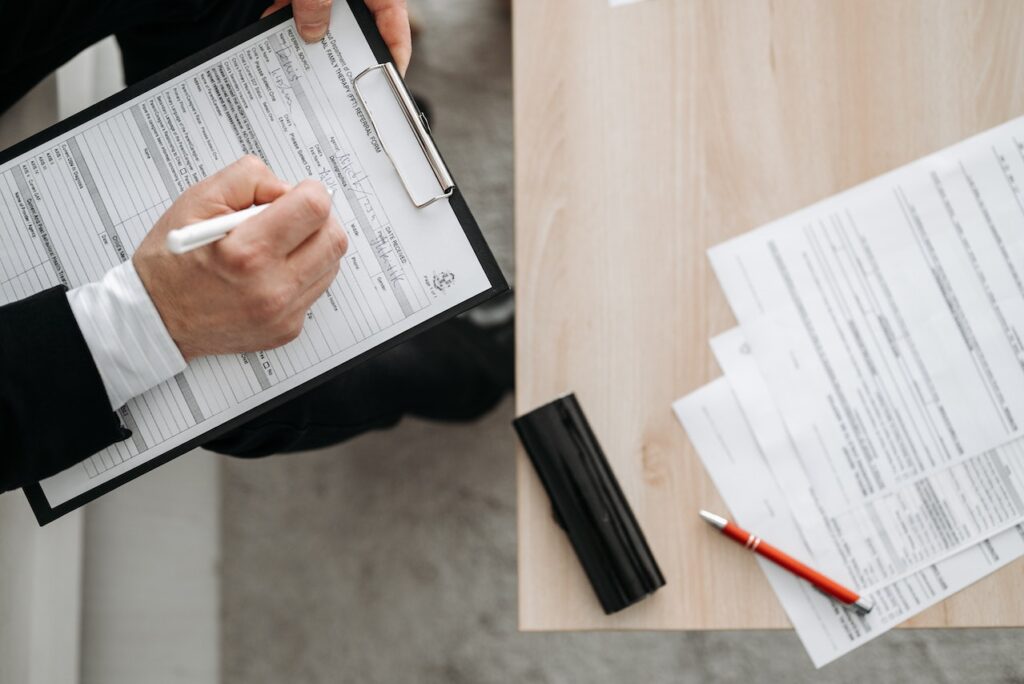Physical Address
304 North Cardinal St.
Dorchester Center, MA 02124
Discover Your Purpose
Discover Your Purpose

If you’ve been involved in an accident and are considering making a personal injury claim, you may be wondering where to start. The personal injury claim process can be overwhelming and confusing, but it’s important to understand the steps involved in order to increase your chances of success. That’s why we’ve put together this guide to walk you through the personal injury claim process, from gathering evidence to negotiating a settlement. It’s important to act quickly when making a personal injury claim, as there may be time limits that apply.

The purpose of this guide is to provide readers with a comprehensive understanding of the personal injury claim process and equip them with the knowledge and tools they need to succeed in their own personal injury case. We’ll cover everything from understanding the new rules for personal injury claims to how to build a strong case and even how to calculate a personal injury claim. By understanding the personal injury claim process, readers can make informed decisions and take the right steps to ensure their case is successful.
By the end of this guide, you will have a clear understanding of the personal injury claim process and how to increase your chances of winning a personal injury lawsuit. So, whether you’re dealing with the aftermath of a car accident or have suffered an injury at work, this guide will provide you with all the information you need to navigate the personal injury claim process with confidence. It is important to note that personal injury claims are extremely complex and require a thorough understanding of the law.

The first step in the personal injury claim process is to gather evidence of the accident and your injuries. This can include things like pictures of the accident scene, medical records, and witness statements. It’s important to document as much as possible as soon as possible, as evidence can disappear or become less reliable over time. It is also important to keep in mind that the opposing side may try to discredit your evidence, so it is wise to take additional measures to protect yourself.
Once you have your evidence, the next step is to file a claim with the insurance company. This involves filling out paperwork and providing them with your evidence. It’s important to be honest and accurate when filling out the paperwork and to provide all the evidence they ask for. You should also be prepared to provide evidence of your losses, such as receipts or estimates of repair costs.

After the insurance company receives your claim, they will evaluate it and make an offer for a settlement. This is where the negotiation process begins. It’s important to have the help of a personal injury lawyer during this stage, as they can help you negotiate a fair settlement. In addition to gathering all the relevant evidence, you should also be prepared to provide proof of the severity of your injury and its long-term effects.
If the insurance company’s offer is not satisfactory, or you are not sure if it is fair, you may consider hiring a personal injury lawyer. A personal injury lawyer can help you navigate the process, negotiate a fair settlement, and represent you in court if necessary. A personal injury lawyer can help you assess the evidence and determine what type of compensation you may be entitled to, including medical expenses, lost wages, and pain and suffering.
In some cases, the insurance company may not agree to a fair settlement, and the case may need to go to court. A personal injury lawyer can help you prepare for court and present your case. Going to court can be a lengthy and complex process, which is why having a personal injury lawyer is so important.
Staying informed about changes and updates to laws and regulations for personal injury claims is crucial, as they can differ based on the location and type of accident. A personal injury lawyer can assist you in keeping up to date and ensuring that your claim adheres to the current rules, making the legal process smoother. The personal injury claim process can be complex and confusing, but with the right guidance and understanding of the steps involved, you can increase your chances of success. Gathering evidence, filing a claim with the insurance company, negotiating a settlement, hiring a personal injury lawyer, going to court, and understanding the new rules for personal injury claims are all important steps in the process. Make sure you know what’s going on and, if you need to, hire a personal injury lawyer to help you get a fair settlement. A personal injury lawyer will be able to guide you through the complex legal process and ensure that your rights are protected throughout.
When you’re injured in an accident, one of the most immediate concerns is the cost of medical treatment. From doctor visits to surgeries, these expenses can add up quickly and can be overwhelming, but it’s important to keep track of all your bills and receipts as they play a vital role in the personal injury claim process.

Being out of work due to an accident can be a major blow, not just physically but financially as well. You are entitled to compensation for any wages you’ve lost as a result of the accident, whether it be for medical appointments or recovery time. Make sure to have documentation such as pay stubs or a letter from your employer to support your claim.
The physical and emotional trauma caused by an accident can be just as damaging as the financial burden. Pain and suffering damages are intended to compensate for the emotional and physical distress caused by the accident. It’s not easy to put a price tag on something like this, but a personal injury lawyer can help you calculate a fair amount.
Losing a loved one or experiencing a permanent and severe injury can also mean losing their companionship, love, and support, which can be compensated through Loss of Consortium damages.
In cases where the at-fault party’s behavior is particularly reckless or negligent, they may be subject to punitive damages. These damages are intended to punish the at-fault party and serve as a deterrent to similar behavior in the future. It’s important to note that these damages are not intended to compensate the victim, but rather to hold the at-fault party accountable for their actions.

When you’re dealing with the aftermath of an accident, the last thing you want to worry about is gathering evidence. But trust us, it’s crucial. Having clear and compelling evidence like photographs of the accident scene, medical records, and witness statements can make all the difference in your personal injury claim. Make sure to document as much as possible as soon as possible, as evidence can disappear or become less reliable over time. And don’t forget to keep all your documents in one place and keep copies for yourself.
Going to see a doctor after an accident is a no-brainer, but did you know that medical experts play a crucial role in building a strong case? They can provide testimony and documentation that supports the extent of your injuries and the impact they have had on your life. It’s important to work with a medical expert who is familiar with personal injury cases and can provide evidence that will be admissible in court.
Rehabilitation can be a long and difficult process, but it’s an important aspect of personal injury cases. Not only can it help you recover from your injuries, but it can also provide evidence of your injuries and the impact they have had on your life. Make sure to document any rehabilitation you undertake, including the type of treatment, duration and progress.

Having a pre-existing condition can make things more complicated, but don’t let that discourage you from pursuing a personal injury claim. It’s important to understand how your pre-existing condition may impact your case and to work with a medical expert who can provide evidence of how the accident has exacerbated your pre-existing condition.
A personal injury claim calculator can be a useful tool when trying to estimate the value of your claim. It’s important to keep in mind that these calculators provide an estimate and are not a substitute for professional legal advice. It is important to work with a personal injury lawyer to determine the true value of your claim.
Building a strong case for your personal injury claim can feel overwhelming, but it’s worth it in the end. You can build a strong case for your claim and get the most money possible by getting clear and convincing evidence, working with medical experts, keeping track of your recovery, understanding how pre-existing conditions affect your case, and working with experienced personal injury lawyers.
Dealing with the physical and emotional aftermath of an accident can be difficult, and the process of filing a personal injury claim can add to the confusion and stress. You may be wondering how to navigate the personal injury claim process and get the fair settlement you deserve. The first step is to gather evidence of the accident and your injuries. This can include things like pictures of the accident scene, medical records, and witness statements. With this evidence, you can then file a claim with the insurance company. But remember, don’t go through this process alone. A personal injury lawyer can help guide you every step of the way and ensure that your rights are protected. When you have been injured in an accident, it is important to document the event.
The car accident claim process If you’ve been in a car accident, the claim process is similar to the personal injury claim process. However, there may be additional considerations, such as determining who is at fault for the accident and dealing with the other driver’s insurance company. With so many moving parts, it’s important to have a clear understanding of the car accident claim process and to work with a personal injury lawyer who has experience handling car accident cases. They can help you navigate the complexities of the process and increase your chances of getting a fair settlement.
The personal injury settlement process Once the insurance company has evaluated your claim and made an offer, the negotiation process begins. It’s important to have the help of a personal injury lawyer during this stage as they can help you negotiate a fair settlement that covers your medical expenses, lost wages, and pain and suffering. The process of negotiating a settlement can take some time, but with the right guidance, you can increase your chances of getting a fair settlement.

How to submit a personal injury claim Submitting a personal injury claim can seem daunting, but it doesn’t have to be. The initial step in the personal injury claim process is to collect evidence that supports the accident and the extent of your injuries. This includes photographs, medical records, police reports, and witness statements. Once you have gathered all the necessary evidence, the next step is to file a claim with the insurance company of the party at fault.
This will typically involve filling out paperwork and providing documentation to support your claim. This typically involves filling out paperwork and providing them with your evidence. It’s important to be honest and accurate when filling out the paperwork and to provide all the evidence they ask for. With the help of a personal injury lawyer, you can ensure that your rights are protected, and your claim is handled properly.
How to file a claim for personal injury Filing a claim for personal injury is similar to submitting a personal injury claim. You’ll need to gather evidence of the accident and your injuries and file a claim with the insurance company. This typically involves filling out paperwork and providing them with your evidence. It’s important to be honest and accurate when filling out the paperwork and to provide all the evidence they ask for. With the help of a personal injury lawyer, you can ensure that your rights are protected, and your claim is handled properly.

Chances of winning a personal injury lawsuit The chances of winning a personal injury lawsuit can vary depending on the specific details of the case. However, having a strong case with clear and compelling evidence can increase your chances of winning. It’s important to work with a personal injury lawyer who has experience handling similar cases and can advise you on the chances of success. Keep in mind that going to court can be a lengthy and complex process, which is why having a personal injury lawyer is so important. They can assist you in navigating the legal system, construct a compelling case on your behalf, and clarify your available choices.
If you’ve been in an accident and have been injured as a result, you may be wondering what steps you need to take in order to file a personal injury claim. The process can be overwhelming, but don’t worry, we’re here to guide you through every step of the way.
The first step in the personal injury claim process is to gather evidence of the accident and your injuries. This can include things like pictures of the accident scene, medical records, and witness statements. Gathering this evidence is crucial for building a strong case and getting the fair settlement you deserve.
After that, you will submit a request for reimbursement to the insurance company. This process may involve filling out paperwork and providing them with your evidence. The insurance company will then evaluate your claim and make an offer for a settlement. If the offer is not satisfactory, you may consider hiring a personal injury lawyer to help you negotiate a fair settlement or represent you in court.
Going through the personal injury claim process alone can be a daunting and overwhelming task, especially if you’re still recovering from your injuries. That’s why it’s so important to seek legal guidance from a personal injury lawyer who has experience handling similar cases. They can help you navigate the complexities of the process, increase your chances of getting a fair settlement, and make sure that your rights are protected every step of the way.

It’s important to keep in mind that even if you have a strong case, there’s always a chance that you might lose your personal injury claim. If that happens, it doesn’t mean that you’re out of options. You may still be able to appeal the decision or seek other forms of compensation. A personal injury lawyer can help you explore all of your options and make sure that you’re getting the best possible outcome.
Photo by RODNAE Productions – back to home
[…] money in the short term, it’s still essential to have adequate coverage for situations like an injury claim. Make sure to review the policy carefully and consider the level of coverage you need to protect […]